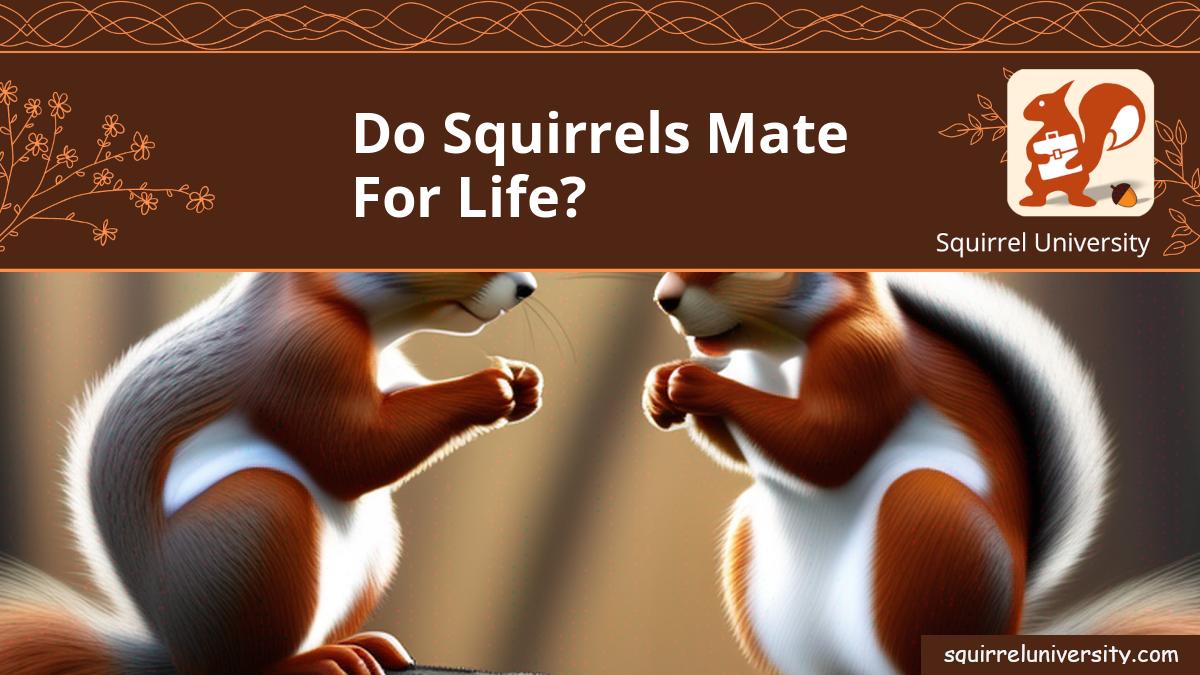As someone who has spent years observing squirrels in their natural habitats all around the world, I’m often asked about their mating and relationship habits. Specifically – do squirrels mate for life? Or are they more promiscuous creatures?
Unlike certain animals such as gibbons that form lifelong partnerships, squirrels do not adhere to the conventional notion of mating for life. However, their relationships and mating habits are more complex than you may realize.
The Mating Chase: How Squirrels Start the Courting Process
Let’s start from the beginning. When a female squirrel goes into heat, this kicks off what’s known as “the mating chase.” A mating chase is precisely what it sounds like – male squirrels will literally chase the female through the trees in pursuit of an opportunity to mate.
Here’s a video of a squirrel mating case:
A female squirrel’s fertility window is extremely brief – just one day each cycle. So when it’s time, she heads out of her territory into others’ lands and makes chattering noises to attract males. They can detect a ready female from up to a 1/3 mile away!
What ensues next is a fast and noisy race through the trees. Multiple males will pursue the female until one eventually gives up and a winner is declared. This dominant male then gets first dibs on mating with the female.
Here’s an interesting fact about squirrels – the female actually gets to choose which male she mates with, regardless of who “wins” the chase. She seems to be able to identify males she’s related to through scent and declines to mate with them. More on that later!
Birthing and Raising Young: A Solitary Effort
After a successful mating, the female squirrel is left alone to birth and raise her young. The average squirrel pregnancy lasts just 35-45 days. Litter sizes range from 1-7 babies, but most commonly they give birth to 3-4.
When baby squirrels are first born, they are completely helpless – deaf, blind, and furless. For the first several weeks of their lives the mother keeps them safely tucked away in a nest called a drey, where she feeds and cares for them.
At around 7-8 weeks old, the young squirrels start to venture out of the nest for short trips. By 10-12 weeks they are weaned off mother’s milk entirely. At this point, they will leave the nest for good and go off to establish their own territories.
As you can see, there is very little family bonding time for squirrels. They spend just 2-3 months with their mother before going off on their own for good. The male squirrel plays no role whatsoever in raising the babies.
Promiscuous Creatures: Squirrels Mate with Multiple Partners
Here’s another interesting squirrel fact – during a mating chase, a female will often mate with more than one male. That’s right, squirrels are actually promiscuous creatures that take on multiple mating partners each season.
This promiscuous strategy is perhaps an evolutionary adaptation to ensure genetic diversity. By mating with many males, the female squirrel gives her babies the best chance at having a variety of strong genes.
No Pair Bonding: Squirrels Go Their Separate Ways
Unlike monogamous species such as seahorses or French angelfish, squirrels do not form lasting pair bonds or mate for life. The male puts in minimal effort towards courtship and mating.
Once he’s mated, his work is done. He offers no support in raising offspring and instead returns to his own territory. The same goes for the female – she raises her babies entirely alone before sending them off on their own.
In rare cases, a male may stick around briefly and help guard the pregnant female or newly-born young. But this guarding behavior usually only lasts a couple of weeks at most.
Mating With Relatives is Avoided
You may be wondering – if squirrels are so promiscuous, how do they avoid accidental incest? As mentioned earlier, female squirrels seem to identify relatives through scent.
Studies show that females can recognize their fathers, siblings, and cousins. They strongly avoid mating with any close family members. This mechanism helps to ensure genetic diversity in their offspring.
Territorial Creatures With Solitary Lifestyles
Though they may live in close proximity to others, squirrels are highly territorial and solitary in nature. Each squirrel claims domain over their own 2-5 acre territory, which they aggressively defend.
They don’t tolerate other squirrels encroaching on their space or eating from their food stores. Even mated pairs don’t stick together or share territory – as soon as mating is over, they go their separate ways.
The only real “family unit” you’ll see is a mother with her young offspring, and even that only lasts 10-12 weeks until the babies leave the nest. Otherwise, squirrels live completely alone.
Squirrels Reach Sexual Maturity Quickly
Squirrels mature and start mating at a remarkably young age. They can start reproducing as early as 5-6 months old. But most don’t get their first chance until they are 10-12 months of age.
Once female squirrels reach sexual maturity, they can mate twice per year – once in early spring, and again in mid to late summer. This means squirrel populations can grow quickly, especially when food is abundant.
Conclusion
So, do squirrels mate for life? While squirrels may occasionally assist with guarding or adopting orphaned young, they do not mate for life or form permanent family units. Their mating strategy is best described as promiscuous.
Females mate with multiple males each season to ensure genetic diversity. Males provide no paternal care and do not stick around after mating. Babies are raised by the mother alone for a brief 10-12 weeks before leaving the nest.
Squirrels are highly territorial and mostly solitary creatures. The only bonds you’ll observe are between mother and offspring. But even that is short-lived, as young squirrels head off to establish their own domains.
So in summary – no, squirrels do not mate for life. They form fleeting seasonal bonds solely for mating purposes. But once the deed is done, they return to their solitary lifestyles.
You may also be interested in reading:


